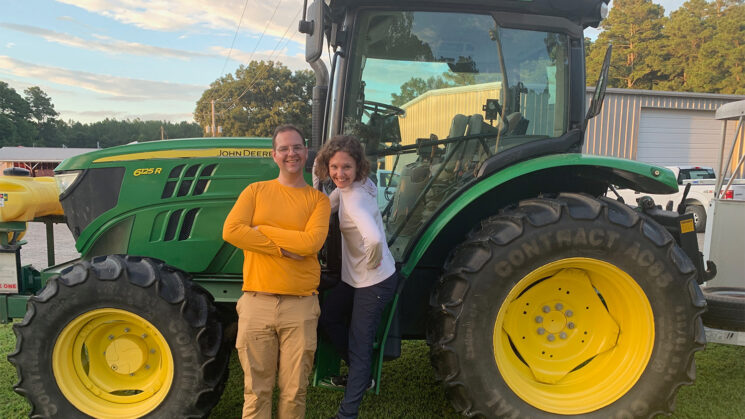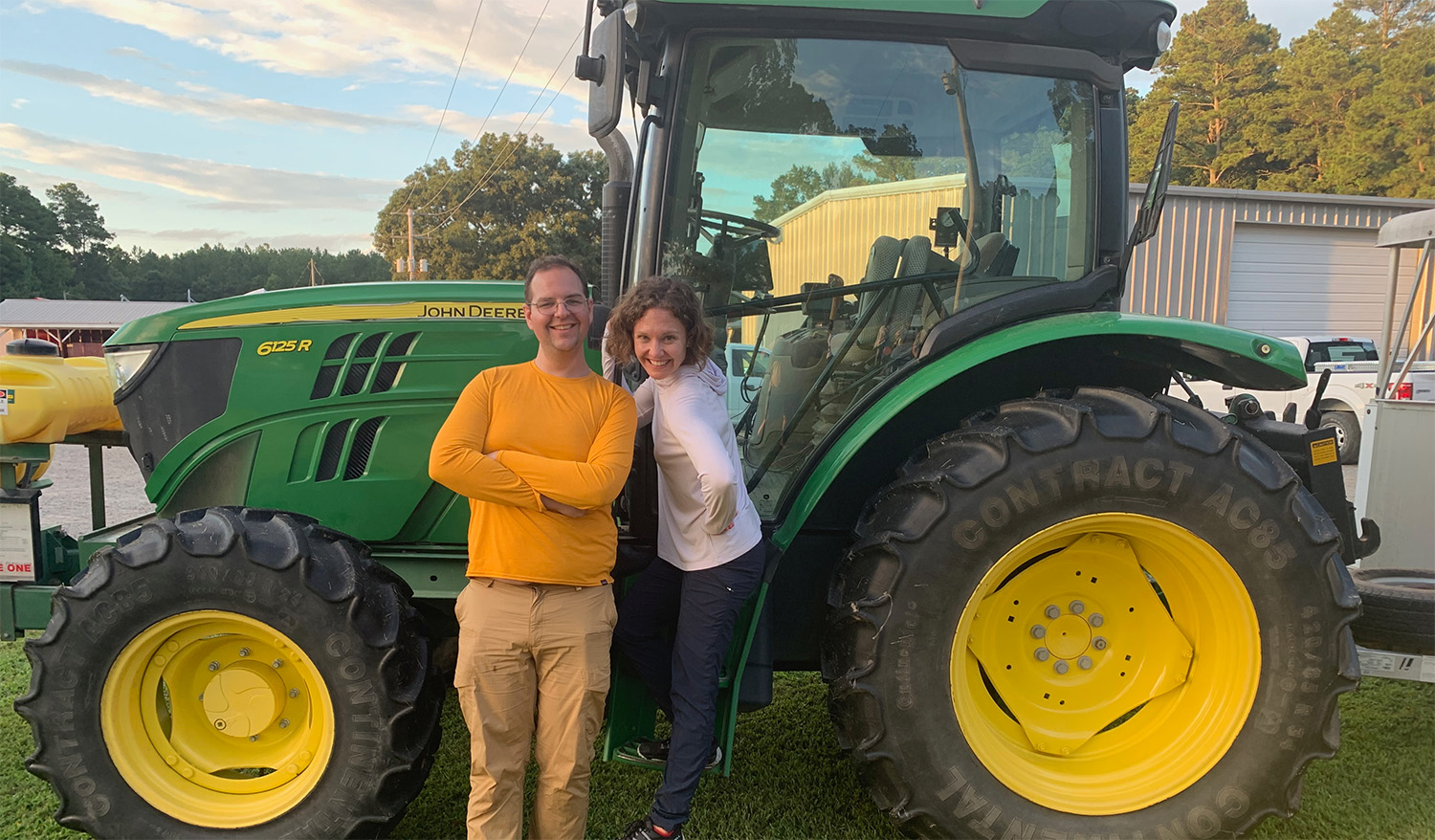
Over the summer of 2022, the last cohort of AgBioFEWS graduate students conducted field research in eastern North Carolina, gaining insights into the intersection of biotechnology, farm size, and environmental shifts on farmers.

Asa Budnick (left) and Jill Furgurson (right) taking a break during their summer field trip in eastern NC
Written by: Asa Budnick and Jill Furgurson
*Note: The opinions expressed in this article are those of the authors as individuals and should not be taken as a reflection of the views of the whole of the Genetic Engineering and Society Center or NC State University.
In the summer of 2022, our cohort of 12 graduate students embarked on an agricultural adventure in eastern North Carolina. The trip included visits to nearly 20 farms, as well as encounters with numerous historians, cooperative extension agents, seed producers, crop consultants, and insurance agents. The two week field experience officially launched our AgBioFEWS Interdisciplinary NSF Research Traineeship focused on the science, policy, and public engagement aspects and impacts of agricultural biotechnology. As members of 11 different disciplines, we each arrived with a unique educational background, perspective, and area of study. By the time we emerged on the other side, we had all gained new depth in our understanding of how biotechnology impacts the complex agricultural socio-ecosystem. The experiential nature of the field course helped us to clarify our own individual perspectives and knowledge of the roles that biotechnology are playing in shaping agriculture. For the purposes of sharing some of those perspectives, two of us have attempted to distill our understanding into two key takeaways.
The scale of industrial agriculture shapes landscapes and livelihoods.
On our trip we had the pleasure of visiting many different farms. The smallest farm we saw was less than 40 acres and focused on organic farming, market gardening, and homesteading. We ate figs fresh from the tree, saw bundles of garlic drying from barn rafters, and left carrying watermelons. The largest farm was 57,000 acres of GM corn and soy. We drove along farm lanes – a flat green grid straight to the horizon. We were swallowed in a sea of soybeans. Most of the farmers that we talked to managed between 300 and 1000 acres in similar rotations of corn and soy. Some farmers included cover-crops and wheat. Farmers may own or lease the land, and many farmers manage a combination of owned and leased acreage. We observed forces directing farmers towards larger scales and similar crop rotations.
Mechanized equipment and chemical inputs characterize Industrial agriculture. While they allow farmers to achieve a larger scale of production with less on-farm labor, many farmers that we spoke to commented on the rising costs and complexity of both machinery and inputs. Farming equipment is trending towards larger, automated machines. These machines are very expensive to purchase and only make economic sense if they are used at full capacity during the harvest. We saw how biotechnology plays a role in this trend. Many GM traits are highly compatible with large scale agriculture as they simplify some management decisions. For example stacked herbicide tolerant corn and soy lines allow farmers to use a simpler regimen of broad-spectrum herbicides which they can apply in fewer passes over a larger area when they use the most modern equipment. A farmer who chooses not to use GM herbicide resistant lines would likely have to spend more time on weed management and could therefore only handle a smaller area.
Biotechnology further interrelates with the scale of agriculture through the industrialized production of seed. On our trip we visited a seed production farm which is a large producer of Bayer GM soybeans. Below the towering grain bins the packing floor was filled with noise and dust as the machines sorted seed. We were told that hundreds of thousands of bushels were grown, tested, sorted, and shipped here. The industrial scale of GM crop production demands immense amounts of seed produced in facilities like the one we visited. It is hard to reconcile the experience of visiting the seed production facility with the idyllic imagery of farming that we hold in our minds.
When viewed alongside a larger social context, it is clear that the industrial scale of agriculture not only affects farmers but also the broader agribusiness sector. Larger farms demand larger infrastructure and a few farmers that we spoke to had diversified into adjacent industries such as shipping, warehousing, processing, and consulting.
One vegetable farmer we spoke to noted that in the past there were more personal relationships with buyers. However, the consolidation of the market has left him with less agency in selling his produce. Many farmers that we talked to noted the trend of there being fewer and fewer farmers and larger and larger farms. These trends pass burdens onto farmers, including high loans which one farmer said kept him up at night. Several multi-generational farmers discouraged their children from farming.
Farmers exist in a world of constant change.
Things are rarely black and white when it comes to farming. However, witnessing the white trails of salt intrusion threading their way into the fertile black soils of Hyde county left a striking image in our minds. Rising sea levels add an element of uncertainty to an increasingly unpredictable agricultural landscape. One farmer described a six inch rise in sea level over the past 30 years as first hand evidence of climate change. As saltwater penetrates productive cropland, farmers are forced to find short-term solutions. The warming climate has become yet another variable in a world of constant change.
The farmers we met were adept at orchestrating complexity. In addition to the vagaries of climate and weather, they must navigate the seemingly endless stream of emerging biotechnologies and market changes. Every few years, farmers using GE crops choose novel seed varieties and manage the associated fertilizer and herbicide inputs. This process demands farmers consult with outside sources of information as they make decisions. We saw one example of how farmers might access industry knowledge and research at the Chrome Regional Ag EXPO. And we heard from various farmers who were devoting acreage to field trialing different traited varieties. Market demands further influence the selection of crops and crop varieties. Citing his own crop conversions, one farmer described changes in tobacco production and economics over the past ten years as a driving force. Another farmer spoke to how changes in lifestyle can hurt produce farmers. As he described how people no longer can or put up food, we came to understand yet another factor influencing the abandonment of diversified produce farming for monocropping.
Labor shortages were invoked by several farmers as another source of flux and challenge. Planting GE crops can lead to reduced labor demands. An organic farmer acknowledged this possibility when he stated there are “not enough people to work with a weeding hoe to feed all the people in the world without biotechnology.” Another farmer cited labor shortages as a limit to cultivating more land, while a third farmer described how labor shortages led him to abandon beans as a crop. Offering yet another view, an agronomist explained that globally, reduced labor demands in agriculture allows women and children more time for education. As students exploring biotechnology in agriculture, these first hand accounts from diverse perspectives increased our understanding of the complexity involved.
Asa Budnick is an AgBioFEWS Fellow and Plant Biology Phd student focusing on molecular biology and genetics in the Sederoff Lab. With a background in gene editing and biotechnology, Asa is deeply interested in food systems and understanding how they can be made more equitable and sustainable with and without biotechnology.. He can be reached at abudnic@ncsu.edu.
Jill Furgursonis an AgBioFEWS Fellow, STS scholar, and PhD student in the Department of Forestry and Environmental Resources. Her current research explores how broader stakeholder engagement can support more inclusive and responsive decision-making around the evaluation of new environmental biotechnologies, such as the genetically engineered (GE) American Chestnut tree. She can be reached at jmfurgur@ncsu.edu.
Related GES Colloquium with AgBioFEWS Fellows, “AgBioFEWS Cohort 3 – Loss and Resiliency in Eastern North Carolina Agriculture” August 30, 2022